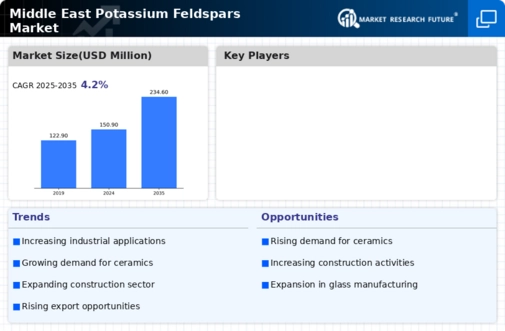Market Analysis
In-depth Analysis of Middle East Potassium Feldspars Market Industry Landscape
The market dynamics of K-Feldspar in the Middle East are influenced by a combination of factors that collectively shape its supply, demand, and pricing trends in the region. K-Feldspar, a key industrial mineral, is prominently used in various sectors, including ceramics, glass, and construction. The Middle East's construction boom and the expanding ceramics and glass industries contribute significantly to the demand for K-Feldspar. The mineral is valued for its role in enhancing the strength and durability of ceramics and glass products, making it an essential component in these manufacturing processes.
Geographical considerations play a pivotal role in the market dynamics of Middle East K-Feldspar. The region is home to substantial K-Feldspar deposits, with countries like Turkey, Iran, and Saudi Arabia being notable contributors to the global supply. The accessibility and abundance of these resources impact production costs and, consequently, the pricing of K-Feldspar in the Middle East. Moreover, geopolitical factors and regional trade dynamics influence the availability of K-Feldspar, creating fluctuations in supply chains.
Environmental considerations are increasingly becoming a significant factor in the market dynamics of K-Feldspar in the Middle East. Sustainable mining practices and eco-friendly extraction methods are gaining attention as environmental awareness grows. Regulatory measures and industry initiatives focused on minimizing the environmental impact of mineral extraction are influencing the operations of K-Feldspar mining in the region.
Technological advancements also shape the market dynamics of Middle East K-Feldspar. Ongoing research and development efforts focus on improving extraction techniques, optimizing production processes, and exploring new applications for K-Feldspar. Innovations in processing methods contribute to the versatility of K-Feldspar, expanding its range of uses across different industries in the Middle East.
Market dynamics are further influenced by the competitive landscape of the K-Feldspar industry in the Middle East. The presence of numerous players, from large mining corporations to smaller enterprises, fosters competition. Companies seek to gain market share through strategies such as investments in technology, exploration of new deposits, and partnerships. The level of competition often impacts pricing strategies, with fluctuations occurring based on supply-demand dynamics and competitive pressures.
Consumer preferences and trends in end-use industries also impact the market dynamics of Middle East K-Feldspar. As consumer demand for sustainable and environmentally friendly products grows, industries utilizing K-Feldspar may experience a shift in preferences towards eco-conscious options. This dynamic is prompting mining companies and industry stakeholders to adapt and innovate in response to changing consumer expectations.
The global economic scenario and macroeconomic factors contribute to the overall market dynamics of Middle East K-Feldspar. Economic stability, currency fluctuations, and trade policies influence the purchasing power of consumers and businesses, affecting the demand for K-Feldspar in the region. Furthermore, economic conditions can impact investment decisions in the mining and processing of K-Feldspar, influencing production volumes and overall market dynamics.



Leave a Comment